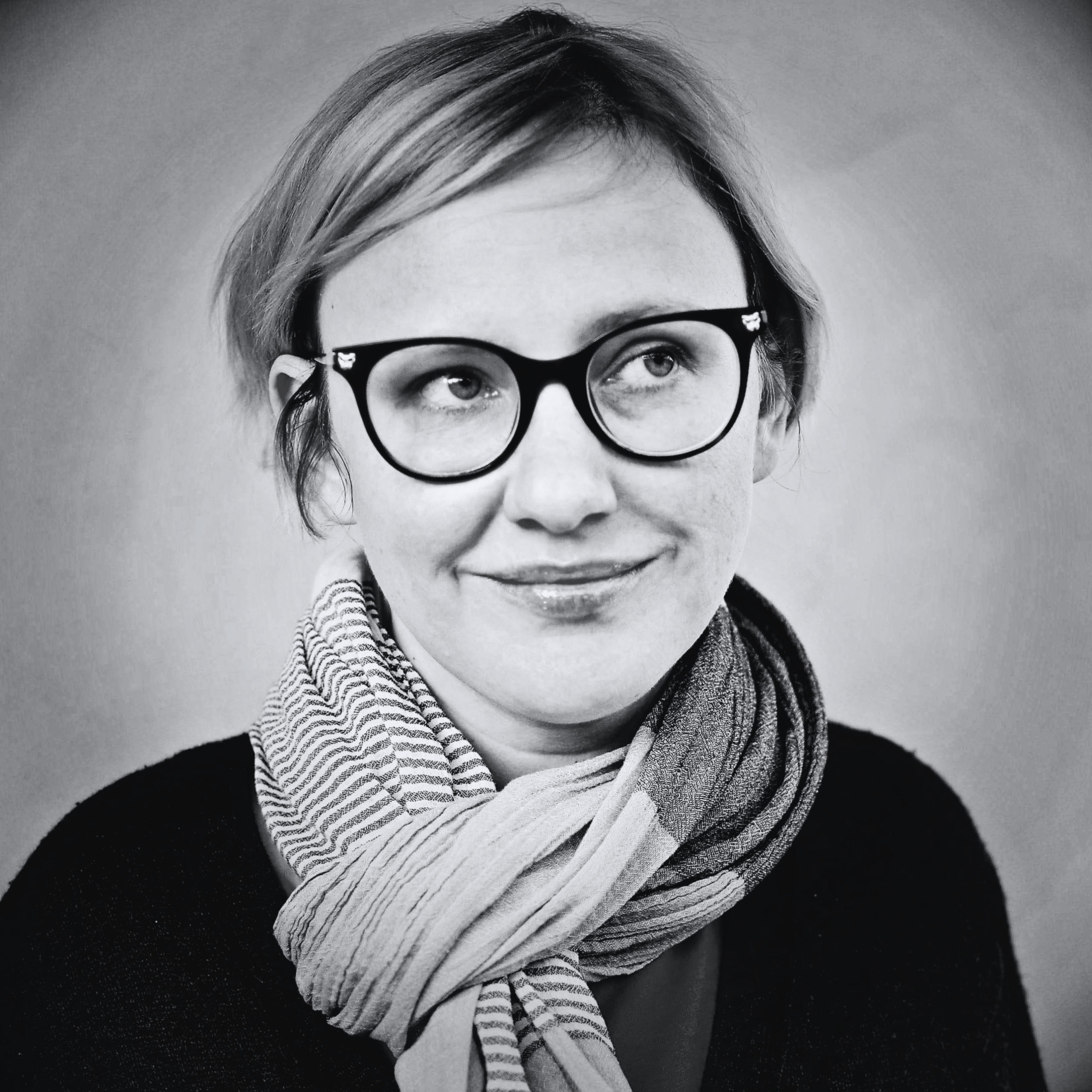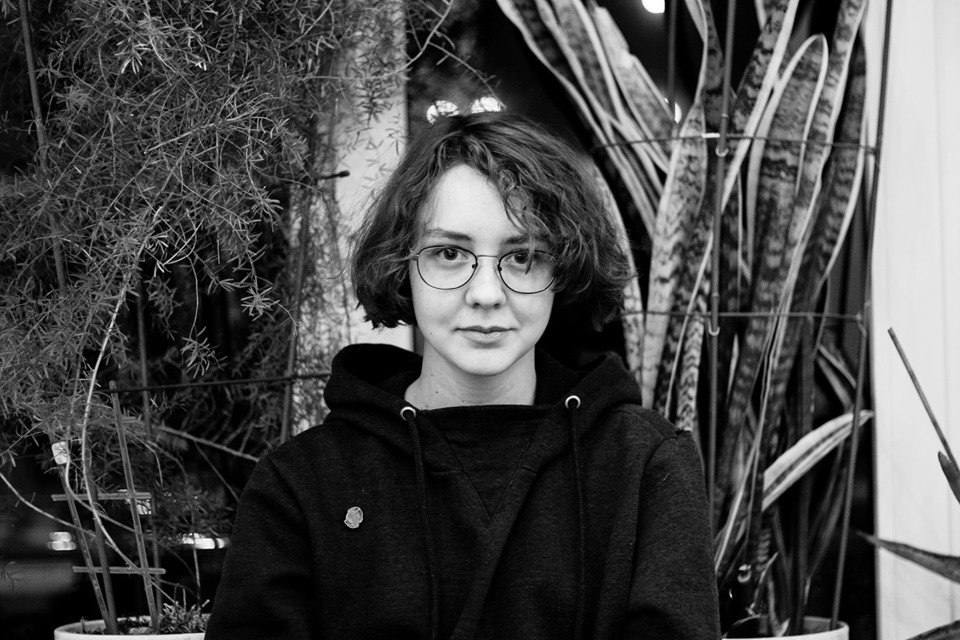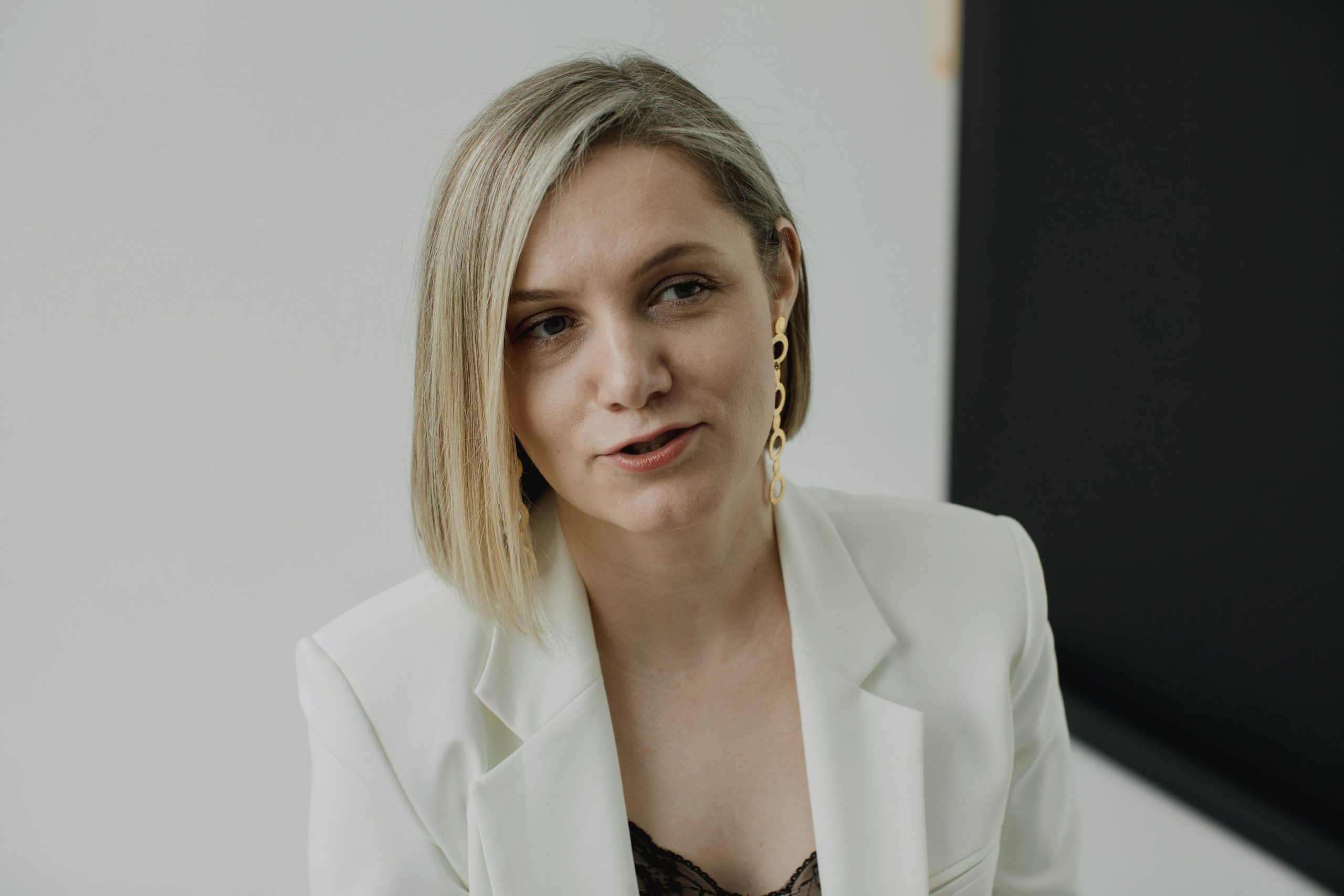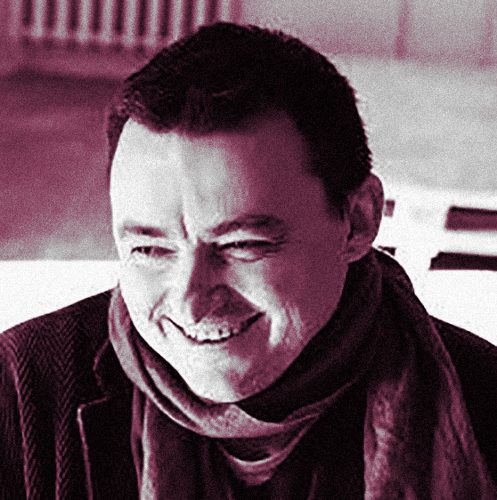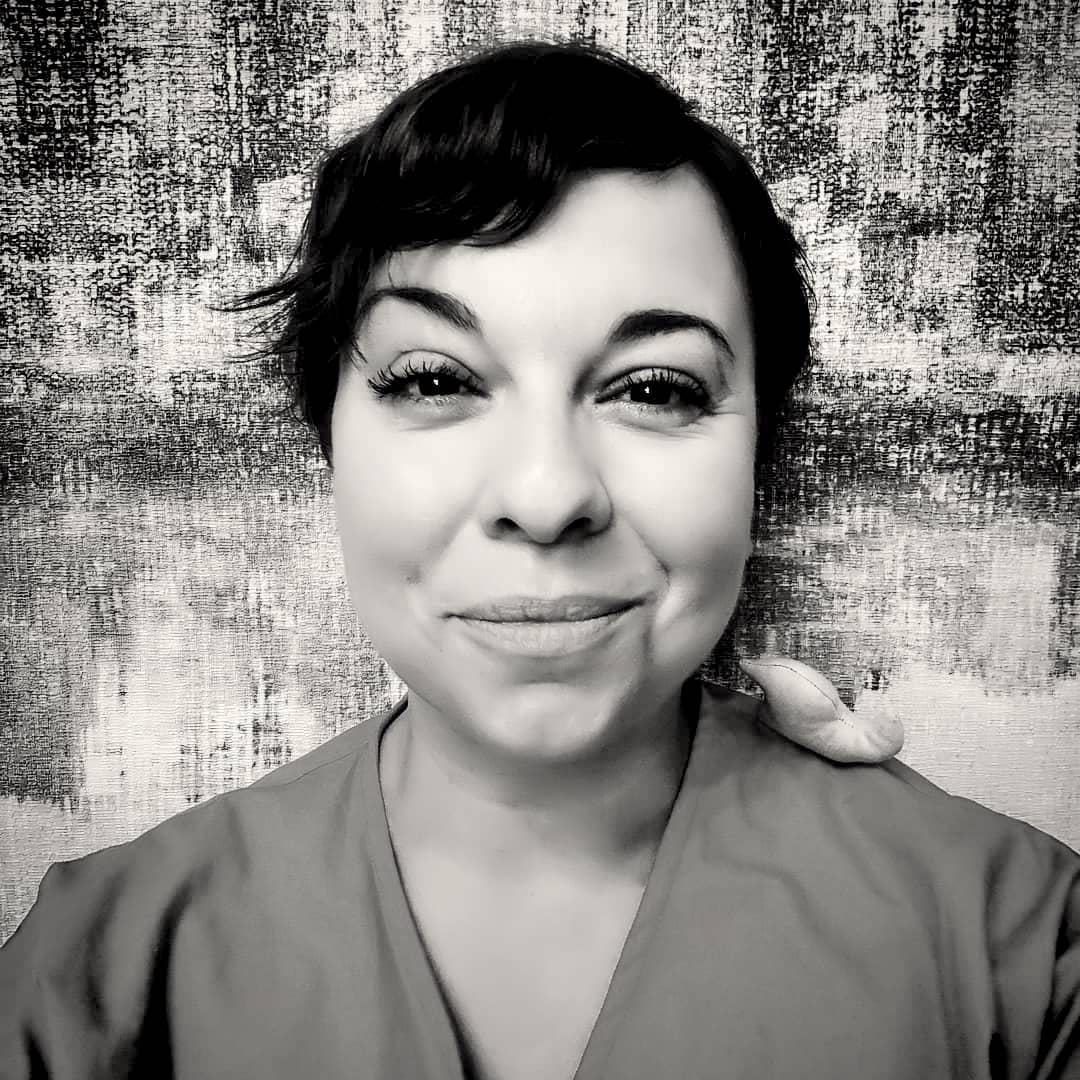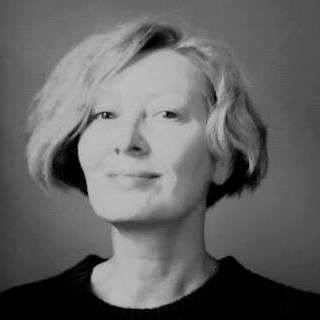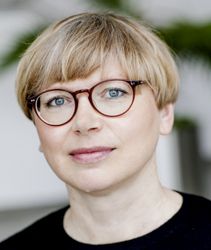“I Refuse to Accept This State of Affairs”: An Interview with the International Coalition of Cultural Workers Against the War in Ukraine
While Russia aggressively wages a major war in Ukraine, how can contemporary art help launch an antiwar movement worldwide? At a time when art workers in the post-Soviet region are more ethnically divided than ever, the International Coalition of Cultural Workers Against the War in Ukraine demonstrates a unique ability to unite around a platform for promoting antiwar and anti-colonial messages. Initially intended as an alternative Belarusian pavilion at the 59th Venice Biennale, this digital platform quickly evolved to include and showcase antiwar artwork from a broad spectrum of countries including Austria, Azerbaijan, Belarus, Bosnia and Herzegovina, Georgia, Germany, India, Mexico, the Netherlands, Serbia, South Africa, Turkey, the United Kingdom, Ukraine and others. Its team consists of a curatorial group from Belarus—Valentina Kiselyova, Anna Chistoserdova, Antonina Stebur, Lena Prents, Maxim Tyminko, and Aleksander Komarov—as well as two curators from Ukraine, Tatiana Kochubinska and Natasha Chychasova. The platform is a part of the European Pavilion, an international program of the European Cultural Foundation launched in 2020, with the first bi-annual event taking place in Rome November 17–19, 2022. It operates in a dual online and offline format, and has already given presentations at Documenta Fifteen in Kassel and Manifesta in Prishtina earlier this year. I met with the curators of the International Coalition of Cultural Workers Against the War in Ukraine in Berlin in August, and we continued our discussion online in September 2022. (During my Art Prospect Residency in July–August 2022, I met with the following curators of the International Coalition of Cultural Workers Against the War in Ukraine: Aleksander Komarov, Anna Chistoserdova, Valentina Kiselyova, Lena Prents, and Antonina Stebur. Our meetings took place several times in multiple locations across Berlin. In September 2022, we finalized our discussion with a Google doc, with Stebur, Prents, Kiselyova, Chychasova, Kochubinska and Tyminko representing the curatorial group.)
Sasha Razor: What is the history of this project?
Antonina Stebur: We were initially working on an alternative Belarusian pavilion at the Venice Biennale. We developed a pavilion platform idea under the working title of Drazdovich TV. We focused on rethinking the possible limitations of the Biennale, which are imposed by national pavilions on the one hand, and by the hero-artist and hero-curator on the other, often featuring statements by one or two artists. Our alternative pavilion was conceived as a point of reflection on the Belarusian protests that began in 2020, which resulted in roughly two percent of the country’s population going through the penitentiary system as well as a large wave of migration. Since contemporary art has been strongly linked to activist movements and political discourse over the past ten years, many artists actively participated in the protests and, consequently, were forced to leave the country. Despite this, Belarus state structures coldly announced a tender for participation in the Venice Biennale only to later hypocritically canceled it, citing the weakness of the submitted concepts. We therefore wanted to create our own project. The Belarusian protests were horizontal, decentralized, and inclusive, a multiplicity we wanted to emphasize. We chose to create a platform that simultaneously represented a polyphony of very different voices and collaborations within the art community in Belarus.
However, when Russia launched its full-scale war on Ukraine on February 24, and Belarus provided its territory for the deployment of the Russian army and military equipment, we understood that we could no longer present Drazdovich TV as it was originally conceived because it was unethical and insensitive. After talking to our Ukrainian colleagues, we came up with the idea of antiwarcoalition.art, the International Coalition of Cultural Workers Against the War in Ukraine. This platform became, in a sense, the successor to our exhibition project Drazdovich TV, because it was also a platform for artistic statements, which included many different voices and contexts. Today, we feature artist statements from many countries: Ukraine, Mexico, Turkey, Belarus, Georgia, Azerbaijan, and South Africa—places where lines of tension have passed or continue to pass, where resistance and various forms of solidarity arise.
As a result of this multiplicity of perspectives, we are able to reflect on our own situation, which we find highly ambiguous and problematic. It is impossible for us as a curatorial group from Belarus to ignore that our country was complicit in the war. At the same time, we fled the country primarily for political reasons. Some curatorial group members emigrated in the 1990s when dictator Lukashenka first came to power, while others fled the persecution in 2020 and 2021. So we find ourselves in a complex situation. On the one hand, we continue to “fight both dictators,” Lukashenka and Putin, as artist Uladzimir Hramovich aptly put it. On the other, we are also representatives of the co-aggressor state. At the moment, our experience can be best described in the words of Turkish researcher Foti Benlisoy as the experience of defeat, from which new strategies and new non-obvious alliances of solidarity can be built. We envision antiwarcoalition.art as a network of solidarity, sharing experiences, talking about new strategies of coexistence, the language of description, and lines of decolonization around the world.

Nastia Teor, ! A T T E N T I O N ! Air Raid Sirens! 2022. 02:28. From antiwarcoalition.art platform
SR: Who is involved in antiwarcoalition.art and how do you distribute work among the group’s members?
Valentina Kiselyova: The idea of the first project, the Alternative Belarusian Pavilion at the Venice Biennale, was initiated by the group of Ambasada Kultury, which I co-founded with Anna Chistoserdova. Since January 2022, we have been meeting weekly. During this time, the team has changed for a variety of reasons. It now consists of eight people: me, Chistoserdova, Antonina Stebur, Natasha Chychasova, Tatiana Kochubinska, Maxim Tyminko, Alexander Komarov, and Lena Prents. There was a great deal of emotional shock when the war began, and we were silent for more than a week. After this difficult mental pause, we decided to change the project and began working on antiwarcoalition.art. It was then that Ukrainian curators Chychasova and Kochubinska joined our team. Among the characteristics of our project are a horizontal approach to project management, open communication, mutual responsibility, transparency, and trust. We discuss strategic, tactical, and pressing tasks, and delegate them based on competence. We also allow pauses for breathing in and out to each team member who needs it.
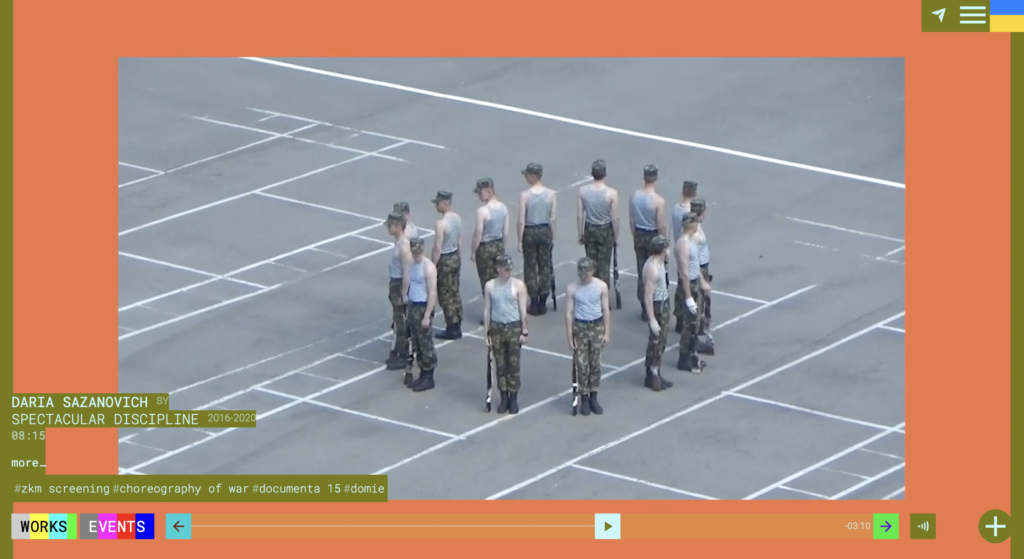
Daria Sazanovich, Spectacular Discipline 2016-2020. 08:15. From antiwarcoalition.art platform
SR: Could you talk about the platform you are using? How did it come about? What was the initial purpose of your online repository?
Maxim Tyminko: The original Drazdovich TV pavilion was designed as a multi-channel online video platform where invited artist-moderators could create and run their own independent “channels,” streaming video works, individual images, or slideshows. But because of the invasion of Ukraine, we radically changed the concept of our project. We also had to change the structure and idea of the online platform. Now antiwarcoalition.art is an open repository for artists’ works and statements related to the themes of war, violence, colonialism, and dictatorship. Any artist can upload their video work to our platform. Of course, not all works are published. New works undergo a short moderation to weed out inappropriate content. But the repository itself is not the ultimate goal of the project. The main goal of antiwarcoalition.art is to popularize and distribute antiwar video art, organize public screenings, and use existing screens in public places, such as lobbies, reception areas, and information points. We believe that contemporary art is a catalyst for discourse and civic engagement, which is why we think it’s important that artists’ work be presented openly and not only seen by the professional and engaged public who attend gallery exhibitions and private video screenings. It is most important to reach ordinary passersby in the street, visitors to museums, cafes, hotels, and train stations. This is certainly no easy task, but I hope we move steadily and systematically toward this goal.

Laura Huertas Millán. El Laberinto (The Labyrinth). 2018. 21:05. From antiwarcoalition.art platform
SR: How do you select artworks/participants for this platform? Could you describe your process?
MT: Antiwarcoalition.art is an open platform. We always have an open call for artists. Anyone can upload a work or several to our platform, but all works are subject to short moderation. On our “Open Call” page we describe some selection criteria: a submitted artwork should be an original, complex, and discursive statement reflecting upon antiwar, anti-dictatorial, or anti-colonial topics. It may not violate the rights of others, and must not be obscene, sexually explicit, defamatory, offensive, objectionable, or harmful to others. At the moment, we have about 100 published works, but we get new works every few days. We don’t plan to limit the number of entries in any way. The bigger our collection, the more diverse the programs we collect for various public shows can be.
Natasha Chychasova: Our selection of works goes two ways. Firstly, we rely on our own experience and knowledge, and we invite artists who are already in our networks. So Tatiana and I were more responsible for representing Ukrainian artists, but we did not stop there. Secondly, to expand our horizon of knowledge about different contexts, we launched an open call with no deadline. It allows us to find new names for ourselves. We discuss each work that appears on the platform in general meetings. It is important for us to keep the selection process horizontal and take into account the opinion of each and every team member. In addition to this path, we also invite artists and women we work with whose practices we feel are important individually. We also try to involve representatives from different professional institutions to include their expertise and knowledge to represent different regional contexts on our platform.
Lena Prents: Antiwarcoalition.art works in the contemporary art scene; we all rely on our contacts and networks more or less. Our goal, however, is for the project to become a strong platform under which like-minded people gather, and for the project to move smoothly from the digital to the analog dimension and back.
AS: It is very important that the International Coalition of Cultural Workers Against the War in Ukraine exists not only online, but also offline through exhibitions, discussions, and workshops, which allow us to talk about the war over and over, to make our small contribution to making sure the full-scale Russian invasion of Ukraine does not disappear from the media. But most importantly, these events serve as gathering places where we can discuss these issues live, inviting artists and researchers. Since the beginning of the Russian-Ukrainian war, I have experienced an anemia of language, as if I don’t have enough words. How does one describe the intolerable complexity of war? To address this question, we always choose a theme for our events, for example, for the program at the Centre for Art and Media (ZKM) in Karlsruhe, we focused on the topic of language. Our program was called “When Language Is Lost: Possibilities of Art in the Face of War: One Day with Antiwar Coalition,” and explores the perspectives of communicating in a situation where the tool of communication is at stake.
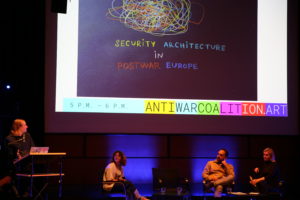
Discussion ‘When Language Is Lost: Possibilities of Art in the Face of War’ at Zentrum für Kunst und Medien (ZKM), 2022. Nikolay Karabinovych, Natasha Chychasova, Vladimir Miladinović, Antonina Stebur. Photo by Beatrice Zaidenberg, ZKM.
SR: I know that at some point Ukrainian art workers agreed not to share platforms with Russians and Belarusians. At least we have witnessed these discussions online and seen several people withdraw their participation. Have you experienced anything similar, and if yes, how did you overcome it?
NC: This question is very sensitive for us, as Ukrainians, and there are both obvious and non-obvious reasons for boycotting Russian and Belarusian art workers. On the one hand, sharing a space with people who are indirectly connected to thousands of deaths in your country leads to a strong affect and the impossibility of constructive conversation. Through rejection, we also resist the ideological construct of “fraternal nations,” which has long been supported and actively used to describe our region. In our project, we give preference to those who were previously invisible in the shadow of the dominant voice of Russia or who were excluded from public discourse altogether. Therefore, we have decided that we will not accept the work of Russian artists unless they have been consistently working with a decolonial theme in their practice. Instead, we are giving a platform to the work of members and representatives of marginalized ethnic minorities, which helps us to highlight the coloniality of Russian politics.
As a Ukrainian, I can say that, for me, dialogue with the Russian side is not possible until the military actions are over and Russia acknowledges all the crimes it has committed against my country. And it is important that Russia’s acknowledgment of its crimes be comprehensive. Otherwise, the imperial view of the Other and the colonial policy will not end, but simply be put on pause. As for Belarus, the situation there is more complicated. In my opinion, the two countries, Belarus and Russia, cannot be compared because, at the moment, Belarus is governed by an illegitimate president who usurped the power despite people voting and protesting against him. I understand and accept the position of Ukrainian artists who refuse to cooperate with Belarusian artists because Belarus has provided its territory for the placement of Russian weapons and airstrikes against Ukraine. But, I still see a big difference between the situation with Russia, the direct aggressor, and Belarus, which is involved in this conflict through the dictatorship of an illegitimate president. Additionally, now more than ever, we Ukrainians and Belarusians need to talk about the fact that there are no “three fraternal nations.” We were colonized, and now we are struggling for our independent existence to reclaim our history and culture. And this struggle took place during both the Russian Empire and the Soviet Union. We are independent and, despite multiple repressions, have repeatedly proven our claims to freedom and our history.
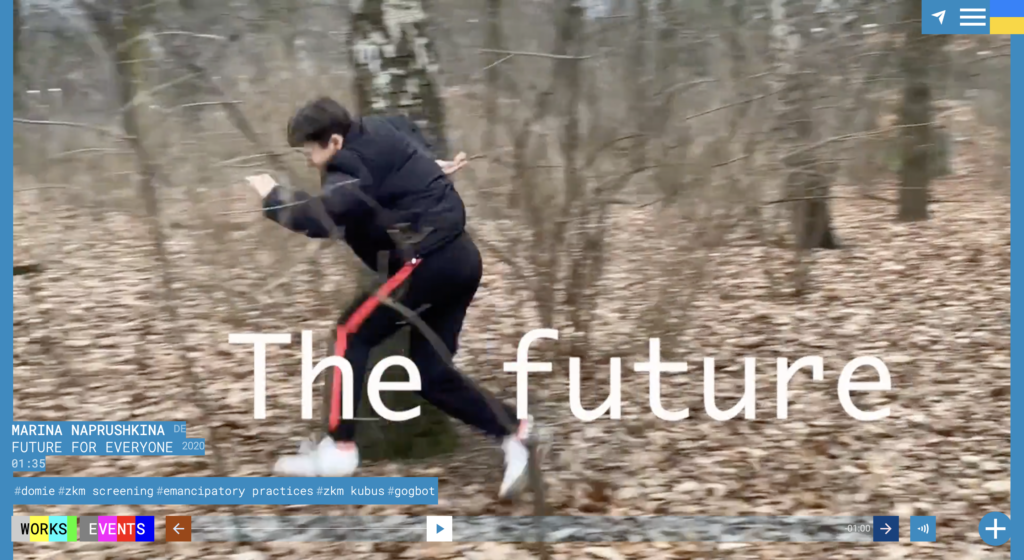
Marina Naprushkina, Future For Everyone. 2020. 01:35. From antiwarcoalition.art platform
SR: How did your participation in Documenta Fifteen and Manifesta come about? How do you see yourselves in the wider context of these two events?
NC: For Documenta Fifteen, we chose the theme “non-human agents in a time of war.” It was the result of our analysis of the work and an attempt to identify similar themes that artists and female artists, in particular, address in their practices. On our platform, you can see works by Katarzyna Wojtczak (Poland) about how non-human agents (birds) become involved in the infrastructure of war. Or works by Kateryna Aliinyk (Ukraine), in which grenades hit the ground and poison it. In our program, we presented practical and theoretical approaches to the problem, inviting both artists and researchers to share knowledge, not only with the audience but also with each other. While preparing the program, together with our speakers, Professor Nigel Clark of Lancaster University, Polish artist Diana Lelonek, and Ukrainian artist Alevtina Kakhidze, we defined the topic of discussion as the impact of war on climate change. An important point for us in this conversation was the idea that the Russian-Ukrainian war is not a local conflict but a global problem. We see this not only in the global rise in food and heating prices and famine in African countries dependent on imports of Ukrainian grain, but also in the threat of a nuclear holocaust and the pollution of the water and land. All this points to the fact that global processes and infrastructures are closely intertwined and that the effect of war is felt by each and every one of us. Talking about the practical part of the program, we had two workshops led by Kakhidze and the group eeefff, who showed different strategies of resistance and support. Alevtina talked about a method of active listening and offered a collective reading and discussion based on her dialogues with representatives of the European art scene. Through these dialogues, she revealed the contradictions between her real needs and the available help. In turn, the eeefff group’s workshop showed how, using very simple and accessible tools, it is possible to disrupt such complex and monolithic systems as railroads. In this way, everyone and everyone can show their subjectivity and dissent and protest against the war, no matter how much public influence or capital you have.
AS: Regarding our participation in Manifesta, we started from the context of Prishtina, where the biennale is taking place this year. We wanted to think about two important points: urbanism and the politics of memory. We sought possible ways of resistance in different colonial contexts and spaces affected by military conflict and political instability. The war destroys stability, routines, and ties. This entails a complex set of problems such as migration and the loss of belonging and identity. The war also ruins the stability of narratives that are being continuously reimagined. The program enables us to consider these questions through the prism of public spaces traumatized by war, oppression, ideology, and patriarchal structures, proposing to look at the stealing relationships and non-obvious networks that appear and fade within fluctuating contexts.

From the antiwarcoalition.art one-day exhibition at Documenta 15, 2022. Photo by Maxim Tyminko
SR: Do you think of yourself as part and parcel of these cyber-activist practices that have emerged in Belarus in the past two years, or inspired by them?
AS: Digital solidarity is a distinctive feature not only of the Belarus protests, and our platform by now is not exclusively Belarusian. We can also see the significant role that technology plays today in the Russian-Ukrainian war. Analyzing the protests in Istanbul in 2013, Zeynep Tufekci metaphorically, but very precisely, wrote that only two things remained after the protests in Taksim Square: tear gas and Twitter. Moreover, digital solidarity is not merely another kind of solidarity but a continuation of how the solidarity practices developed throughout history. I find it interesting to think of boycotts as suspensions of work, the rail war in Belarus as a suspension of the railroad infrastructure, and the cyber-activism as digital suspension. To protect the protesters during the Belarus uprising, photographers stopped shooting faces close up so these people could not be identified in case of detention. Similarly, in Ukraine, they do not shoot the movement of Ukrainian military equipment. They don’t put it online so they don’t “hand over” the location to the Russian military. This digital suspension has much in common with suspension as resistance and solidarity in the industrial sphere. In this sense, our antiwarcoalition.art also exists in two dimensions. On the one hand, we exist as an online platform where artists can post their work, and on the other, we also exist in an offline format. Our exhibitions, screenings, discussions, and workshops are designed to provoke discussion and develop a language of reflection. We want people to understand that we are not all isolated. The war in Ukraine is embedded in a complex economic, colonial, and political context. It is not a conflict between two countries, but a war that affects the whole planet through grain distribution, environmental disasters, the threat of nuclear disaster, water pollution, etc. In this respect, our digital strategy is also global.

antiwarcoalition.art project at the 𝐂𝐨𝐚𝐥𝐢𝐭𝐢𝐨𝐧 / КОАЛІЦІЯ / 𝐊𝐨𝐚𝐥𝐢𝐜𝐣𝐚 / КААЛІЦЫЯ exhibition in Poznan, Poland, 2022. Photo by Maxim Tyminko
SR: Have you thought about archiving or digital preservation? What is the future of digital artworks emerging today?
MT: The future of digital works is quite bleak. There is still no coherent and publicly available strategy for digital preservation. Traditional methods of archiving and preservation do not work in the context of unstable media, such as digital art. Accelerating technological progress often does not allow for backward compatibility, leaving artwork that depends on outdated technology to gradually die out. Of course, if the work ends up in the collection of a wealthy institution, it may have a chance at prolonging its life for a period. But the farther away in time we get from the point where tech companies stop supporting a particular technology, the more expensive and increasingly difficult it becomes to keep a work alive in its original state when it depends on certain outdated hardware or software. Modern principles of conservation and restoration under such conditions can at best preserve information—“metadata” about the work that existed and its characteristics—but cannot preserve and provide us with the experience of perceiving the work as it was intended by the artist. And in my opinion, the problem here is not only in the methods of archiving but more in the general approaches and expectations that we associate with a work of art. Gallerists, collectors, curators, art institutions, art conservators, and the artists themselves are used to and expect that once a work of art is marked as “finished” by the creator, it becomes an untouchable fetish that should never be disturbed or altered under any circumstances. But this only works and is acceptable in the world of traditional object-oriented art. Technological art, however, requires constant intervention, adaptation to equipment, format changes, etc. Until we develop a culture of such intervention, we won’t have the necessary standard methods and tools for maintaining digital art.
SR: My last question: What are the tangible results of your project, and how do you envision its future?
AS: This is a good question and one that we are thinking about and discussing a lot. The International Coalition of Cultural Workers against the War in Ukraine was created during the first weeks of Russia’s full-scale invasion of Ukraine. It was important for us to make a modest contribution, make the war more visible, and set the field for discussion. We were all in a state of shock and heightened emotion. Today these emotions continue to dominate, but unfortunately it has become clear that the war has entered a long-term phase. Part of the art community continues insistingthat art is powerless in the face of war, but our whole team believes that art has the tools to help us overcome our frustration, process our emotions, and make some initial reflections. The antiwarcoalition.art project was born out of the impossibility or at least incredible difficulty of articulating what we are going though in words. We continue using this optics today by connecting contexts, experiences, and practices in order to find a new language for this situation. I find these discussions incredibly important because they form a whole layer of pre-reflection, or reflective sketches, so to say, that help us overcome our predicament and see the complex networks of interconnectedness in our world. We also see our platform as the basis for a future archive, that is, an archive of a global artistic community that is united by the desire to end the war as well as the patriarchal hierarchies of power. We are all united by the hope that the world can change. In the words of Ukrainian artist Kateryna Lysovenko: “I dissent. Although a warless world is still impossible, I refuse to accept this state of affairs.”(https://galeria-arsenal.pl/wystawy/kateryna-lysovenko-ogrod-cmentarny)
This article is part of the Special Issue on Art and Solidarity. You can read the other articles included in the issue:

